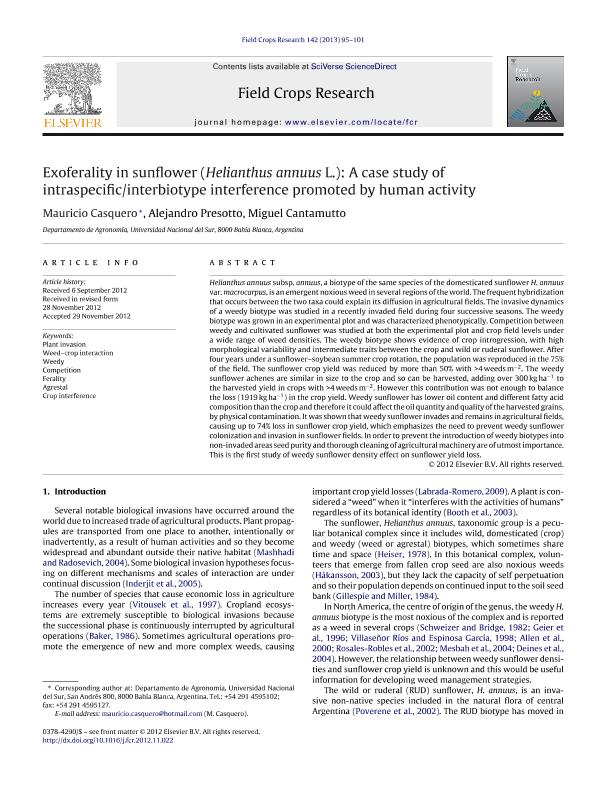Mostrar el registro sencillo del ítem
dc.contributor.author
Casquero, Mauricio Javier

dc.contributor.author
Presotto, Alejandro Daniel

dc.contributor.author
Cantamutto, Miguel Ángel
dc.date.available
2017-02-02T21:05:18Z
dc.date.issued
2013-05
dc.identifier.citation
Casquero, Mauricio Javier; Presotto, Alejandro Daniel; Cantamutto, Miguel Ángel; Exoferality in sunflower (Helianthus annuus L.): A case study of intraspecific/interbiotype interference promoted by human activity; Elsevier Science; Field Crops Research; 142; 5-2013; 95-101
dc.identifier.issn
0378-4290
dc.identifier.uri
http://hdl.handle.net/11336/12397
dc.description.abstract
Helianthus annuus subsp. annuus, a biotype of the same species of the domesticated sunflower H. annuus var. macrocarpus, is an emergent noxious weed in several regions ofthe world. The frequent hybridization that occurs between the two taxa could explain its diffusion in agricultural fields. The invasive dynamics of a weedy biotype was studied in a recently invaded field during four successive seasons. The weedy biotype was grown in an experimental plot and was characterized phenotypically. Competition between weedy and cultivated sunflower was studied at both the experimental plot and crop field levels under a wide range of weed densities. The weedy biotype shows evidence of crop introgression, with high morphological variability and intermediate traits between the crop and wild or ruderal sunflower. After four years under a sunflower–soybean summer crop rotation, the population was reproduced in the 75% of the field. The sunflower crop yield was reduced by more than 50% with >4 weeds m−2. The weedy sunflower achenes are similar in size to the crop and so can be harvested, adding over 300 kg ha−1 to the harvested yield in crops with >4 weeds m−2. However this contribution was not enough to balance the loss (1919 kg ha−1) in the crop yield. Weedy sunflower has lower oil content and different fatty acid composition than the crop and therefore it could affectthe oil quantity and quality ofthe harvested grains, by physical contamination. It was shown that weedy sunflower invades and remains in agricultural fields, causing up to 74% loss in sunflower crop yield, which emphasizes the need to prevent weedy sunflower colonization and invasion in sunflower fields. In order to prevent the introduction of weedy biotypes into non-invaded areas seed purity and thorough cleaning of agricultural machinery are of utmost importance. This is the first study of weedy sunflower density effect on sunflower yield loss.
dc.format
application/pdf
dc.language.iso
eng
dc.publisher
Elsevier Science

dc.rights
info:eu-repo/semantics/openAccess
dc.rights.uri
https://creativecommons.org/licenses/by-nc-nd/2.5/ar/
dc.subject
Plant Invasion
dc.subject
Weed–Crop Interaction
dc.subject
Weedy
dc.subject
Competition
dc.subject
Ferality
dc.subject
Agrestal
dc.subject
Crop Interference
dc.subject.classification
Agricultura

dc.subject.classification
Agricultura, Silvicultura y Pesca

dc.subject.classification
CIENCIAS AGRÍCOLAS

dc.title
Exoferality in sunflower (Helianthus annuus L.): A case study of intraspecific/interbiotype interference promoted by human activity
dc.type
info:eu-repo/semantics/article
dc.type
info:ar-repo/semantics/artículo
dc.type
info:eu-repo/semantics/publishedVersion
dc.date.updated
2017-02-02T14:07:00Z
dc.journal.volume
142
dc.journal.pagination
95-101
dc.journal.pais
Países Bajos

dc.journal.ciudad
Ámsterdam
dc.description.fil
Fil: Casquero, Mauricio Javier. Consejo Nacional de Investigaciones Científicas y Técnicas; Argentina. Universidad Nacional del Sur. Departamento de Agronomía; Argentina
dc.description.fil
Fil: Presotto, Alejandro Daniel. Universidad Nacional del Sur. Departamento de Agronomía; Argentina. Consejo Nacional de Investigaciones Científicas y Técnicas; Argentina
dc.description.fil
Fil: Cantamutto, Miguel Ángel. Universidad Nacional del Sur. Departamento de Agronomía; Argentina
dc.journal.title
Field Crops Research

dc.relation.alternativeid
info:eu-repo/semantics/altIdentifier/url/http://www.sciencedirect.com/science/article/pii/S0378429012004108
dc.relation.alternativeid
info:eu-repo/semantics/altIdentifier/doi/http://dx.doi.org/10.1016/j.fcr.2012.11.022
Archivos asociados
